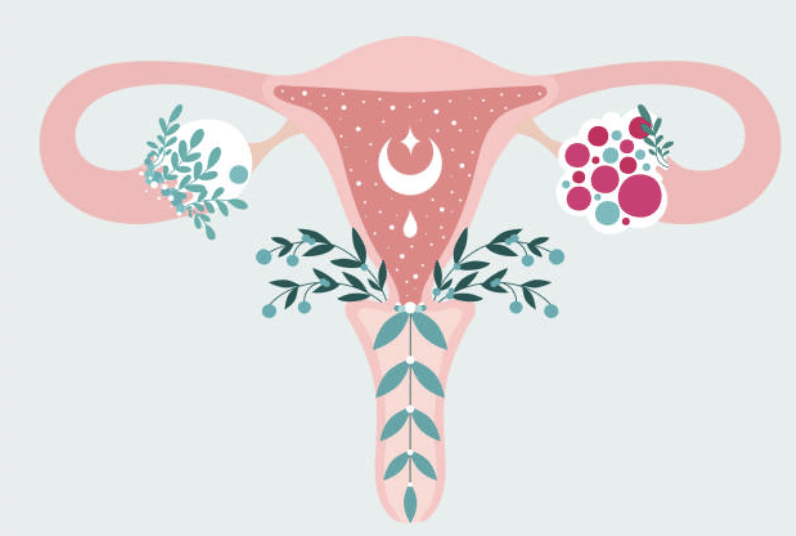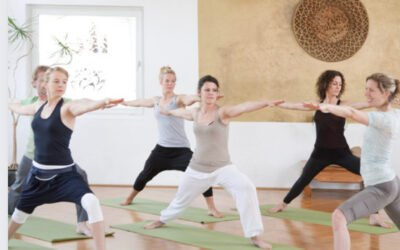Endometriosis is a gynecological disease that is fortunately talked about more, but not yet enough. Just like adenomyosis. They both affect the uterus but are different and are still poorly known and understood today.
What is the difference between endometriosis and adenomyosis?
How to relieve your pain with yoga and natural solutions?
How to help your students with adapted yoga?
In this article, we highlight these two gynecological conditions in order to better understand them and especially how you can accompany yourself or your students with yoga and natural solutions to better live endometriosis and / or adenomyosis on a daily basis.
Important: Remember that it is not normal to have pain during or outside your period. Consult your doctor, gynecologist or specialist if symptoms handicap your daily life.
The information on this site and this article does not provide any medical advice, diagnosis or treatment and is in no way intended to replace the services and advice of a doctor or other qualified health professional. In case of questions or doubts, questions after reading this article, do not hesitate to talk to your doctor or specialist.
What is endometriosis?
Endometriosis is a chronic inflammatory disease that affects 1 in 10 women to 1 in 7 women, or more than 2.5 million women in France. Despite awareness and information efforts, it still takes an average of 7 to 10 years to be diagnosed, often leaving women facing a long medical wandering.
Endometriosis is characterized by the migration of tissues similar to the uterine mucosa (the endometrium) and which develop outside the uterus, often to go to the ovaries, fallopian tubes, but also organs and tissues far from the uterus, such as the bladder, the digestive system, the lungs and even the diaphragm.
This tissue reacts under the effect of female sex hormones and behaves in the same way as the endometrium. It thickens, disintegrates and bleeds with each menstrual cycle, which contributes to inflammation, pain and possible adhesions between the pelvic and abdominal tissues and organs.
Endometriosis can be asymptomatic and completely gone unnoticed. It is then often detected during a fertility check-up when a pregnancy tends to be delayed. It can also cause symptoms that affect daily life, sometimes very intense and disabling pain during and outside menstruation.
The main symptoms of endometriosis:
- Pain during menstruation or ovulation
- Abundic periods
- Chronic pain
- Pain during sexual intercourse
- Back pain
- Chronic fatigue
- Fertility disorders
- Digestive disorders
- More sensitivity to stress, anxiety and depression
- …
The list is unfortunately not exhaustive and the symptoms affect the physical, mental, emotional…
A complex disease, it requires consulting an endometriosis specialist to make the right diagnosis and offer adapted care that can be multidisciplinary.
Holistic approaches and natural solutions can also help improve quality of life and relieve the ailments associated with endometriosis. We talk about it a little later in this article.
This free masterclass is for yoga teachers and health professionals who meet women with endometriosis. It will allow you to better understand endometriosis and how you can help your students through yoga. Access the free audio here.
What is adenomyosis?
Adenomyosis is a condition that is less talked about but that affects many women. However, it is common because it affects more than 10% of the female population. It is more frequent as we age, assimilating to a process of aging of the uterus.
In the case of adenomyosis, the endometrial tissue develops inside the muscle wall of the uterus (the myometrium), causing its thickening and enlargement. It is therefore different from endometriosis because it generally does not involve the growth of tissues outside the uterus. Some women may have both endometriosis and adenomyosis in 6 to 20% of cases. However, a woman can have endometriosis and no adenomyosis, such as having adenomyosis and no endometriosis.
Adenomyosis can also cause symptoms similar to endometriosis, such as:
- Heavy periods (hypermenorrhea)
- Periods that can be long
- Intense pain during menstruation
- Pain and feeling of pelvic heaviness
- Fertility problems
- Fatigue
- …
How to distinguish endometriosis and adenomyosis?
A specialist will be able to establish a diagnosis by proposing the most appropriate methods. In both cases, it will first be a history (a complete questionnaire) to know your symptoms, your medical history… and a physical examination.
Imaging techniques can then be carried out to establish and confirm the diagnosis of endometriosis and/or adenomyosis: depending on the case, endovaginal, rectal ultrasound, MRI, histological analysis of tissues…
Complex diseases, I recommend that you consult a specialist or a dedicated center to establish the diagnosis. They have the experience to look for the different locations of endometriosis and adenomyosis and propose the treatment that will be most appropriate for you. Many centers open in all regions of France.
In the case of endometriosis, a contraceptive or hormonal treatment may be offered. They can help silence the disease and relieve the symptoms but do not cure it. Unfortunately, it can also reoffend following a surgical operation that consists of removing the lesions.
Many women with endometriosis and/or adenomyosis are turning to natural solutions, including yoga, to relieve their symptoms and improve their quality of life. Let’s see how these disciplines can help women better experience endometriosis and adenomyosis on a daily basis.

Yoga and natural solutions to relieve endometriosis and adenomyosis
Yoga and natural solutions exist to help you soothe your ailments and better live with endometriosis and/or adenomyosis and more depending on them.
Studies have also shown the interest and effectiveness of yoga and acupuncture to relieve pain, improve physical and emotional well-being and more generally the quality of life of women.
The High Health Authority (HAS) also recommends these disciplines to women and more and more research encourages professionals to integrate them in addition to medical care.
Relieve the pain of endometriosis / adenomyosis naturally
Adapted yoga practices and natural care can act as an SOS solution to soothe pain when it is felt. They are often specific to each person.
- Yoga postures adapted to facilitate menstruation, calm cramps and soothe pain (it is not necessarily a posture “against” menstrual pain that will help the woman the most)
- Targeted breaths to relax nervous tensions that contribute to physical tensions
- Gentle self-massages to relax painful uterine muscles
- Plants to reduce spasms and cramps and reduce inflammation
- …
You will find in these articles interesting information to better relieve endometriosis:
Relieve your pain with these 5 yoga postures for endometriosis
How to practice self-massage for a healthy menstrual cycle and less menstrual pain?
Painful periods: relieving by breathing with Apana’s breath
A holistic approach
The solutions proposed are often to alleviate symptoms. Yoga and traditional approaches such as Ayurveda, traditional Chinese medicine or naturopathy, recommend adopting a global holistic approach to the person to go to the source of the imbalances causing discomfort and symptoms and thus act more deeply and in a more sustainable way.
They therefore do not rely solely on the painful part of the body. This vision includes lifestyle adjustments (nutrition, adapted movement, stress and emotion management, regulatory plants…) but also proposes to reduce aggravating factors to endometriosis and adenomyosis.
Here are the pillars on which yoga can contribute, for example:
- Soothe your relationship with your condition, your body, by bringing more acceptance and sweetness towards yourself
- Calming and regulating the nervous system that is unbalanced in the face of stress or negative emotions for a long time will trigger a whole hormonal cascade that can unbalance good hormonal function
- Promote blood and energy circulation to nourish pelvic tissues and organs by ensuring their proper oxygenation and release blockages that cause cramps and tensions
- Reduce inflammation
- Facilitate menstruation and the good natural process of discharge and elimination of “menstruation”
- Regulate the immune system, often failing in case of endometriosis / adenomyosis
- Promote the proper elimination of toxins in the body, responsible for liver overload, a key organ for the transformation of hormones and the elimination of excess estrogen
- Support the proper functioning of the digestive system, which is considered in Ayurveda as the key to our good health
- …
These disciplines also make it possible to accompany care pathways that can be stressful and anxiety-provoking to potentiate the results and the good of the person.
In addition to adapted postures and breaths, yoga offers us the contribution of meditations to act on its perception of pain, the impermanent phenomenon of its state…, mudras, sankalpas and visualizations…
Well guided and adapted to the personalized needs of the person, he offers him keys to return to his state of “wholeness” and soothing body, head and heart, to better live endometriosis / adenomyosis on a daily basis.
If you want to train and specialize in yoga and Yogatherapy adapted to endometriosis / adenomyosis to better support your students, the next foramtion session to become an EndoYoga Flow certified teacher starts on June 1. Early bird rate until Sunday evening. Link to the complete description in bio
In conclusion, endometriosis and adenomyosis are two common gynecological conditions that can cause similar and disabling symptoms in the daily life of the woman who suffers from them. They remain different and require appropriate medical support, often multidisciplinary. There are indeed as many endometriosis as there are women.
Yoga and natural solutions can be effective keys to help balance and relieve pain and sustainably improve the quality of life of women with endometriosis and adenomyosis.
Whether for endometriosis or adenomyosis, we will seek to soothe physical, mental and emotional tensions but also to adopt a personalized global, integrative and holistic approach to relieve the daily life of women, not only at the pelvic and matrix level but at the level of all body, heart and head systems.
Do not hesitate to contact me if you have any questions, wish to exchange, be accompanied or train.
Become an EndoYoga Flow® certified teacher
If you want to train and specialize in yoga and Yogatherapy adapted to endometriosis / adenomyosis to better support your students, the next session to become an EndoYoga Flow certified teacher starts this fall in September 2023.
Early bird rate until August 15, 2023.
See the description of the EndoYoga Flow®, a 50h Yoga Teacher Training for endometriosis

See the description of the EndoYoga Flow®, a 50h Yoga Teacher training for endometriosis



0 Comments